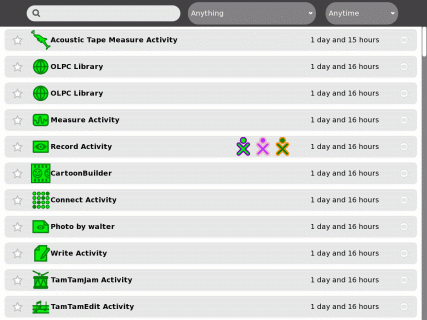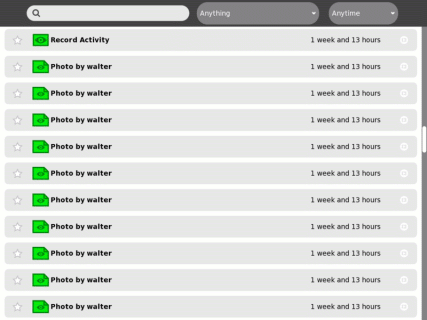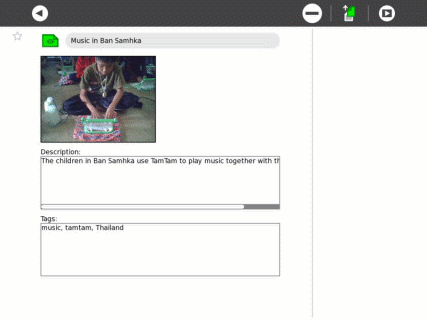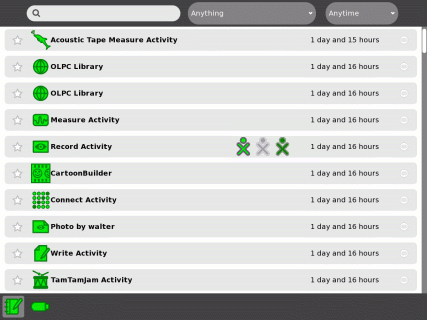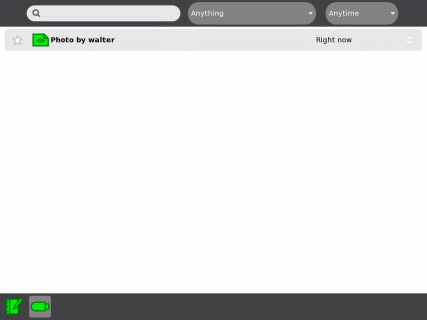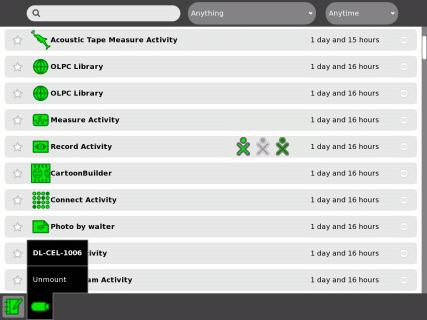Journal Activity
Image:Support-banner-square.png|173px|community support pages rect 0 0 135 204 [1] rect 135 0 345 204 Support FAQ rect 0 205 135 408 [2]
- Comment : there's some whitespace here:
rect 135 205 345 408 Other support
- maybe desc none is better. testing.
desc none
</imagemap>
The Journal activity is an automated diary of everything a child does with his laptop. The Journal can be used by children to organize work or revisit a past project, and by teachers and parents to assess a child's progress.
The Journal activity provides an intuitive interface for viewing projects and files saved by the XO user. Both a Step by Step guide to journal functions and a Getting Started Guide are available to help you use the Journal effectively.
The Journal is also used to access external media (USB sticks, etc.); delete files; and access the backup system (for those of you connected to a School Server).
Basics
Every time you run an activity, it creates an entry in the Journal. The main view can be searched or sorted; clicking on an entry takes you to the detail view.
There are six fields for each entry (some of which may be empty): the star; the entry icon; the entry name; the friends list; the entry date; and a resume button.
Clicking on the entry icon (or the resume button) will resume the activity. Clicking on the entry name will bring up the detail view of the entry.
Many activities store data in the Journal. For example, the Record activity stores an individual entry in the Journal for each picture you take.
Whenever you download a file, it is stored as a Journal entry. You open the file by resuming the entry.
Detail view
The entry can be "starred" or renamed. A description and tags can also be added. These text fields are searchable.
From the menu, entries can be removed or resumed.
- go back to main view
- erase an entry
- copy entry to clipboard
- resume entry
Hovering over the resume button will bring up the resume options for the entry.
Search and sorting
From the main menu, you can search for keywords and tags or sort by entry type or date.
External storage devices
The XO automatically mounts external storage devices such as USB flash drives. They appear as icons at the bottom of the Journal.
You access an external storage device by clicking on its icon; you can open files directly from the device or drag them to (or from) the Journal.
When using an external USB flash drive, it is necessary select the desired type of file "text" that is on the pen drive. The Journal will not automatically refresh to show the contents of the external USB flash drive. Be aware that the Journal does not display the contents of the USB flash drive as a hierarchy of directories containing files; instead it lists all the files one after the other. Thus it may be difficult to locate a particular file on a large drive.
Unmount the external device by selecting unmount from the hover menu. Then you can remove the device.
Installing activities
.xo bundles that are downloaded from the Browse activity are stored in the Journal (in the figure above, there is an entry for the Stopwatch.xo bundle). By resuming the activity from the Journal entry will both launch it and install it on the taskbar.
To uninstall an activity, delete the entry from the Journal. It will be removed from the taskbar the next time you start your XO.
Additional notes
Alternate Access
- The Journal is always available on the Activity Circle in the Home View.
- The "magnifying glass" key on the top row of the keyboard can be used to open the Journal.
Screen Shot
- You can take a screen shot by typing ALT+1. The screen shot is stored as an entry in the Journal.
Datastore
- The Journal stores files in:
/home/olpc/.sugar/default/datastore/store
Copying Files
- Files can be copied to and from the Journal's datastore using the Terminal Activity. However, filenames are heavily hashed, meaning "myfile.bzip" might show up as 2637-4737-13323-dl77nf, or some such gibberish. Here's how to figure it out.
- Note how large the file is (or what time it is.)
- Download it. (Click on the link while you're in Browse.)
- Open Terminal Activity.
- At the prompt, type cd .sugar/default/datastore/store/ to get into your datastore directory.
- Then type ls -la and look for the file with the size and timestamp you noted before.
- Do whatever you want with your file (rename, move, whatever...)
- On more recent releases the two copy-to-journal and copy-from-journal scripts can be very helpful when using Terminal to interact with Journal entries, the scripts can also be downloaded for older releases, see copy-to-journal and copy-from-journal for more information.
- Alternatively, if you're trying to get your file on a USB thumbdrive...
- Pop a usb drive in your usb slot. (It should show up in Journal.)
- Download your file (Click on the link while you're in Browse.)
- When your file is done downloading, go to Journal.
- Click on your file to go to its Journal page. (Your file should be the latest Journal entry.)
- Click on the copy icon at the upper right and hover for a few seconds; your usb drive will show.
- Click on the usb drive and it will save your file to the root area of that drive.
As a final alernative, USB thumbdrives are mounted in the fileystem at /media, so you can use mv and cp to and from that point.
